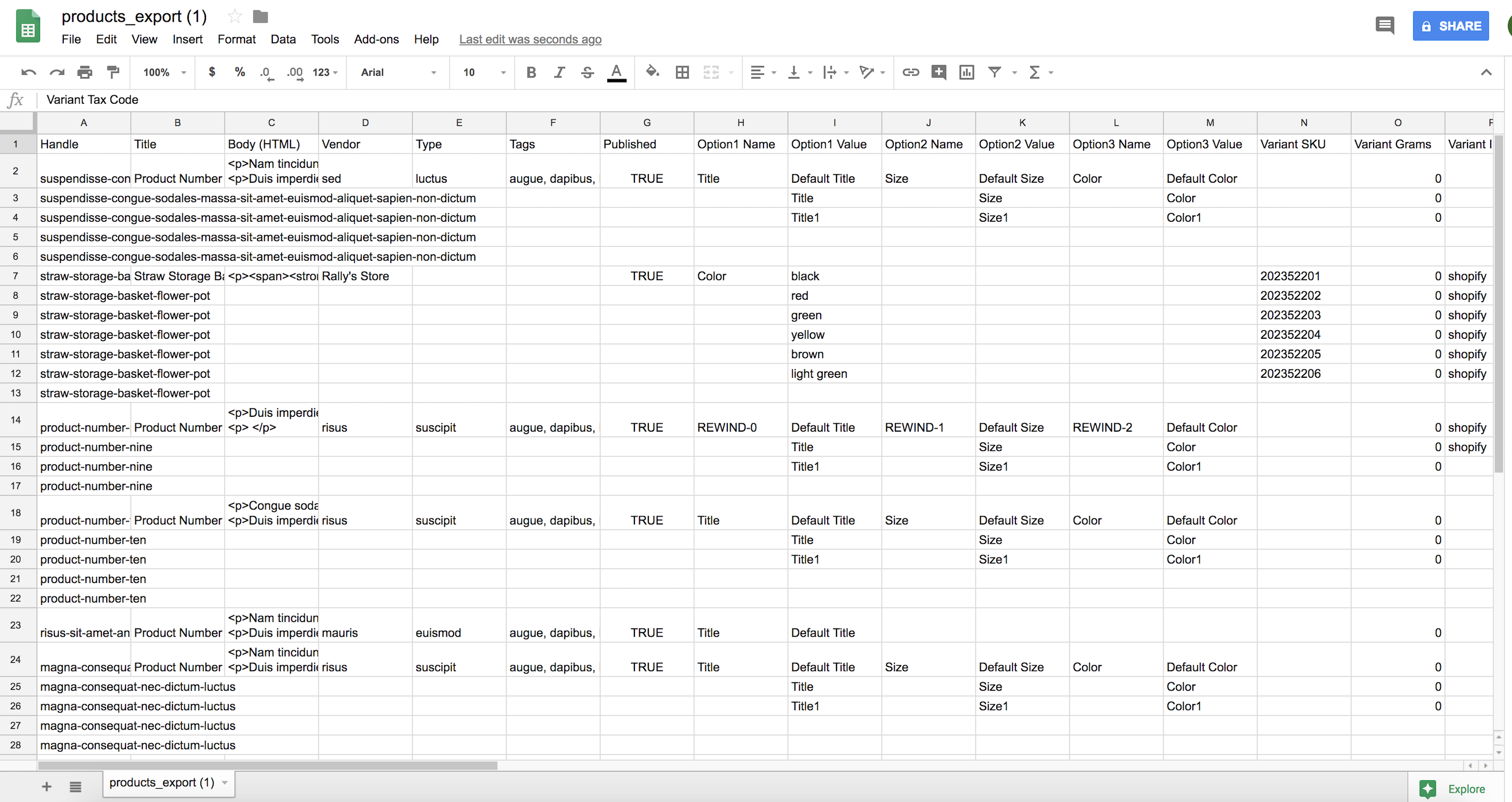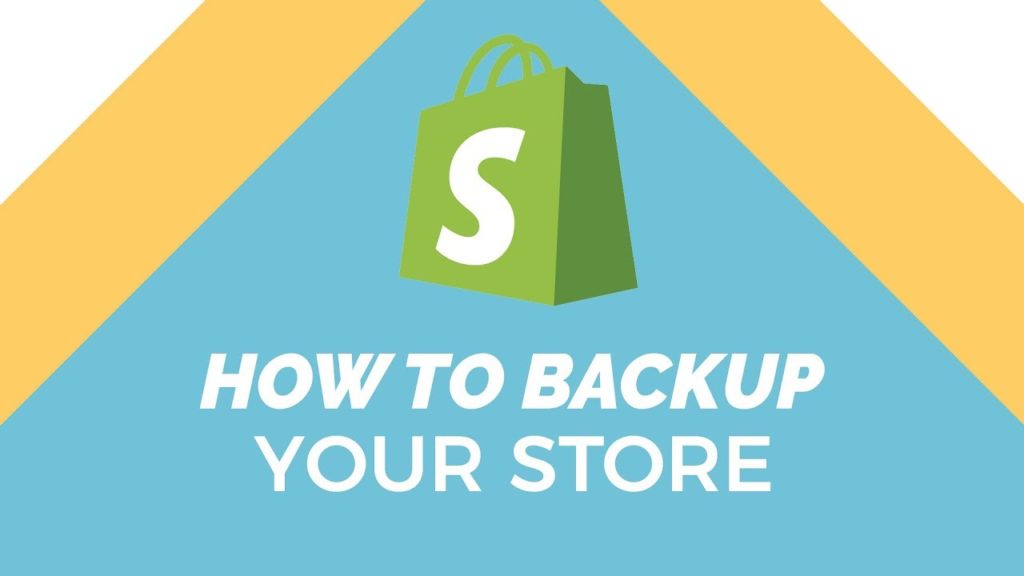Should You Delete Files Uploaded to Shopify
Updated April 2021
Having a backup for your Shopify store is a recommended best do to ensure the security of your concern-critical data. It's like an ecommerce insurance policy for your online store. At that place's no worse feeling than deleting something and realizing that it's gone forever.
"But wait", you might be thinking. "Doesn't Shopify support my store?" The curt respond is no. Shopify performs platform-wide backups, just it cannot restore your individual account information (read more here). Similar many SaaS apps, Shopify users are responsible for securing their account-level information under the Shared Responsibleness Model.
Thankfully, there are diverse means yous tin can protect and secure your Shopify store from any error or disaster and prevent expensive downtime. Nosotros'll outline three different ways you can get most backing up and restoring your data. Which one will you use for your Shopify store?
TLDR: If you're looking for the fastest and easiest way to backup and restore your Shopify shop, expect no further than Rewind Backups. We automatically support your Shopify store every day and get in easy to restore information when needed.
Fill-in Shopify
Pick 1: Manually Backup and Restore Your Shopify Store
Step ane – Export Data to a CSV file
Shopify suggests that merchants tin use CSV files to perform a manual backup of their shop. Information technology is important to notation that you cannot export your entire store – but parts of it. The following data tin can be exported from your Shopify store using CSV files:
- Products
- Customers
- Orders
- Gift cards
- Discount codes
- Theme
For each of the items listed, become into your Shopify Admin, get to Products or Customers (so along), and so click Export. At present that you take a CSV file of your data, it'south important to exist aware of the issues that come with this method.

NOTE: Shopify warns merchants of the post-obit:
- Sorting your CSV file in a spreadsheet program can cause product variants or prototype URLs to become disassociated
- Importing a CSV file that has been sorted might overwrite your existing products with bad data, which cannot be recovered
- Once data is imported for a CSV file, it cannot be undone
For an in-depth guide, we compiled this web log mail service: CSV files and Your Ecommerce Store: Everything You Need to Know.
Stride 2 – Copy and paste particular properties
Shopify exports selective data – information technology only includes what Shopify deems to be relevant. Unfortunately, this doesn't include custom categories for products, doesn't capture images, or how your store has archived and indexed items. This information must be copied and pasted into a document or spreadsheet program.
If this step is non completed and you lot were to restore a product from your CSV files, other than the product catalog, you would need to recreate backdrop as needed from the CSV data. For case, if a product was deleted you would somehow accept to archive and index it. If you deleted an image for a product, it is gone forever. The use of CSV files is extremely express for the reasons mentioned above.
Step three – Copy and paste remaining shop data that Shopify could not export
To support the information in your store that Shopify cannot export, manually copy and paste the rest of your store into a spreadsheet or word document. For case, a blog post will require you to copy and paste the content, category, and whatsoever images included.
Step four – Organize backed up data
Now that all your Shopify store data is backed upwards, organize it in a way that is easy to access and call back when needed.
Step 5 – Secure your backup
Hackers, malware, and disgruntled employees can threaten the security of your Shopify store backup. Hither are iii things yous tin can do to ensure that your store information is safe.
- Utilise encryption – Your data will be protected by lawmaking that can only be unlocked past a set number of keys that are given to authorized users. The keys must be kept in a protected place to ensure unauthorized users don't decode the files.
- Follow the three-2-ane rule – keep three copies of a backup, across 2 different mediums, and ane off-site.
- Test regularly – this volition identify any vulnerabilities of your backup before disaster strikes
Step six – Repeat steps 1-5 regularly, to capture new changes made to your Shopify shop
Because this is a manual process, steps 1-five must exist repeated whenever a change is made to have the nearly authentic and upwardly-to-date backup. Creating a backup schedule or assigning a team member to this task can ensure that your manual backup is always up-to-date.
Step seven – When a minor mistake is made or disaster occurs in your shop, import CSV files
This process looks different depending on the type of data restoration you are trying to accomplish. Let's say we are dealing with a CSV file containing products.
If you are wanting to restore all of your products – from your Shopify dashboard import the product CSV file and the changes will be reflected in your store.
If you are wanting to restore a single product or subset of products – if y'all are to make a pocket-size mistake, yous demand to sort through the CSV (which contains ALL of your products) to import specific changes to the afflicted subset of data. This is a timely chore, which is some other reason why nosotros do not recommend CSV files as a backup solution.
Step 8 – Paste remaining shop information from your fill-in
Items such as web log posts and product images have to be manually entered to restore your store. If any information is missing from your CSV file, or other documents, yous would need to recreate the properties as needed from the raw data.
Option 2: Building a Fill-in Solution for Your Shopify Store
Earlier getting started, delight note – this is a simplified guide. At that place are many things to consider when creating a fill-in tool such as being GDPR compliant, abiding past data storage regulations, and implementing all-encompassing data security measures to ensure the condom of the shop and customer information.
If you have plenty resources on your team and are thinking about building a backup solution for your Shopify store, here'due south how to get started:
Footstep 1 – Use Shopify's public APIs to create a backup tool
To use Shopify'due south APIs some steps must exist taken, which can be found hither – Getting Started with Shopify's APIs.
In that location are many different APIs bachelor through Shopify, each with its uses. Once you accept a improve agreement of the APIs that are bachelor, you tin can then program out how to leverage them to get all the bachelor information from your store, and at what frequency – and so y'all can try to capture the changes you're making. This will require building out the infrastructure to support making these API calls to Shopify, handling the responses that Shopify sends back, and how to properly store the information you receive.
Step two – Secure your backup
The same steps as outlined in Step 5 in the previous section.
This stride is crucial. If the programmer building this tool cannot guarantee the security of the information, it may non be worth it. The security of your shop and customers' data is at run a risk if this step is non met, which can accept devastating impacts on your business concern.
Stride 3 – Regular testing and maintenance on the backup solution you've congenital
From our feel backing upward Shopify stores since 2015, nosotros tin can tell you that one of the biggest challenges is keeping up with Shopify's changing APIs. Shopify recently announced some updates coming to their APIs, almost notably in versioning.
This means that if you build a fill-in solution today, it may become broken soon subsequently if your app doesn't support the new versions of the APIs. This would take a large impact on your resources if a breaking change gets introduced. Information technology is critical that y'all continue upward to date with Shopify'southward APIs and regularly test your solution. This will place any vulnerabilities of your backup before disaster strikes.
Step four – When disaster strikes, sort through your information and effigy out what needs to be restored
This is typically the function that most people overlook, and then pay close attention!
When performing a restore function in your backup, you take to sort through the data that was backed upwardly. This looks unlike depending on if you take backed upwards some items or your whole store. Additionally, this procedure volition vary depending on if you are restoring a deleted detail or an before version of an item (or store). At that place may be multiple items affected, because of the dependency they have on i another, and the order of operations.
Option three: Set Rewind & Forget It
Going through the process of manual backups or creating your own backup solution isn't a terrible idea, only if you don't know how or don't want to, let Rewind Backups for Shopify take care of it!
Our solution automates daily backups of your Shopify shop. Rewind protects the data that drives your business by monitoring and capturing changes as they occur, allowing you to revert and restore whatsoever minor mistakes or disasters. We are able to practice this by using all of Shopify's public APIs to ensure that we provide the nigh holistic and accurate backup for your store.
Our defended squad continuously works with these APIs and is on tiptop of every modify that comes forth. We look at backups from Shopify'south perspective. This allows us to backup and restore the information accurately, and in the same format that Shopify expects. This is one of the reasons why Rewind is the only fill-in and recovery solution that is certified for all merchants, including those on Shopify Plus. This means no duplicates and ensuring tertiary-party dependencies keep to work.
Paul Goldston asked, "share your top 3 Shopify apps and why"
1. Rewind – It's cheap insurance
— Kurt Elster🛍 (@kurtinc) November twenty, 2020
2. Klaviyo – Marketing automation with the tightest Shopify integration
3. Privy – Impressive pop-up builder to turn anonymous visitors into subscribers. Great for running giveaways too
Backup Shopify
As experts in cloud-to-cloud information backups, security is at the core of everything nosotros do. Our priority is to provide a reliable, secure, and transparent service.
Just take a look at the complete list of security measures at Rewind: rewind.com/security
How Rewind Backups Piece of work
Backing UP Data
In that location are three ways Rewind works to make sure your Shopify shop is always backed up:
- Automatic backups every nighttime at 12:00 am local time to capture new changes
- Real-time, automatic backups while you work on your Shopify store
- Launch a transmission backup whenever yous need it

Rewind is a set it and forget information technology system and we send a weekly summary e-mail that lists how your backups have been updated.
RESTORING Data
You have a lot of flexibility in how y'all restore your data. Y'all tin can use Rewind Backups to restore:
- A single item through the Rewind Vault, without losing any subsequent piece of work
- A group of items through the Account Rewind tab
- Your unabridged Shopify store – encounter how easy it is in the video beneath!

The age-onetime question: Export, Build, or Buy?
If data backups are important to you – and they must be since you're reading this – you lot should exist using ane of the three options. Call u.s. biased, but we recommend using Rewind – the pick that volition put the least amount of strain on your team and provide the broadest coverage of your Shopify store.
The price of a developer'southward fourth dimension to create and maintain a backup solution will add together up chop-chop, equally well as manual backups. Manual backups require you or someone on your squad to spend hours each calendar week maintaining regular exports and searching for the data needed for restores. The holes in these solutions can lead to devastating effects on your Shopify store. Take it from ane of our customers, Andrew Saunders:
"Do yourself a favour and download this plugin. Even though I have not used it – I wish I had downloaded it on my other store when sixty% of my product images were deleted after importing a CSV file and costing me weeks of piece of work locating and uploading the images again. Don't take the risk."
Rewind takes care of your backups and restores for a low monthly fee, letting your team focus on what it does best. Backups are our passion and our bread-and-butter: we alive and breathe backups so y'all don't have to!
Rewind Re-create can even duplicate your entire store in minutes, allowing yous to build safely in a test environment, set up wholesaling or international stores, and more.
View all of Rewind's Backup-equally-a-Service apps, or first your free trial today!
Backup Shopify Today
danielsvirinarlecou.blogspot.com
Source: https://rewind.com/blog/three-ways-to-backup-your-shopify-store/
0 Response to "Should You Delete Files Uploaded to Shopify"
Post a Comment